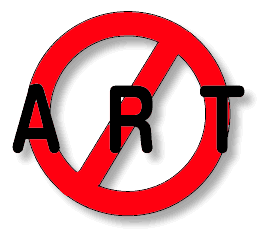
National Fine Art Moritorium ProjectOur nation has reached a state of cultural crisis. And as you know desperate times often require desperate means. Our Colleges and Universities have since the late forties been producing trained professional artists, craftspersons, as well as related management and historians at an increasing and unprecedented rate.
In turn, this has
resulted in a tremendous
growth in the number of tangible artworks i.e.:
The past fifty years has seen the creation of some the greatest individual artistic achievements of our nation's history. But unfortunately, it has been accompanied by an inevitable decline in the over-all quality of the Art produced. The shear volume of Art students enrolled in our academies in proportion to the number of trained instructors precludes the controls required to produce the caliber of Art our country desperately needs.
Ordinarily, market forces would prevail in a Darwinian selection
process, weeding out the dross. But a combination of factors have combined
to skew natural tendencies:
The ART GLUTAnd it's accumulating at an alarming rate. These are not your rare masterpieces or works of genius, most of which get absorbed into the aesthetic mainstream. We're talking about studies, mackettes, second rate paintings, multiples, and literally millions of dated creative exercises and personal statements which have far out lived their usefulness in today's society. Lacking sufficient wall space and pedestals to accommodate this mass of Art, we are needlessly warehousing the Art. Converting our decaying but valuable lnner-city industrlal corridors from potential housing to storage spaces for these cultural baggages and artifacts.
And we've lost our creative focus along the way. Precious energy and resources wasted. In an effort to address this mounting miasma and re-align our cultural backbone, we, here at the National Fine Art Moratorium Project, are offering some proposals to help solve this impending nightmare: Number One: The MoritoriumA voluntary one year moratorium on the further creation of Art objects and other related products and promotions.This will give us all a chance to step back and reassess where we've been and what the future holds. A chance to step outside the galleries, studios, and workshops and engage in a dialog of our creative nation and our needs as a united community. A chance to re-educate ourselves, perhaps to travel, or to re-affirm our spiritual values. An opportunity to address the many challenges faced by our communities, friends, and families.
Number Two: The MillenniumWe propose the Moratorium begin on January 1, 1999 and culminate in a grand celebration on the first day of the new Millennium, year 2000.We understand that for some, a one year moratorium might cause financial hardship to those who actually support themselves and others through the production and sale of Art. Afterall, we here at N.F.A.M.P. are artists too. So, for those of who can clearly demonstrate need, we propose replacing our State and National Endowments for the Arts programs with a program to pay artists NOT TO MAKE ART. Perhaps. federal welfare block grants could be temporarily diverted to such a use. We're thinking along the lines of Franklin Roosevelt's New Deal programs of the thirties, where farmers were paid not to grow crops.
Maybe even private sector Corporate or Foundation money could
be re-channeled.
Number Three: Artists Helping ArtistsThis financial assistance would by its very nature have to be stringent. Many artists could no longer maintain their current lifestyles.Think of this as an Art Fast. And those artists who are well-heeled could extend a hand of generosity to fellow artists who might be less well off.
Number Four: National Fine Art Landfill MonumentThe establishment, by the year 2001, of the National Fine Art Landfill Monument.A solemn repository for homeless Art, to be located in an isolated sub-desert, somewhere in the glorious southwestern United States. The landfill, accessible by rail, would allow Artists to easily and in-expensively ship their works to the site, where trained personnel could separate out any recyclable materials, and bury the rest in this sanctioned location.
Number Five: Visitor's CenterLocated near the landfill site would be a bermed and landscaped Observation Point as well as a Visitor Center. Designed as a Japanese garden with out- door seating, for peaceful contemplation or just a family picnic.Artists could visit and observe their works which have rejoined nature in a respectful environment. Additional tourist traffic would infuse the local economy with needed revenue and provide a possible venue for public concerts and lectures by artists.
In Conclusion:1999 is just around the bend, so don't hesitate to respond with your support.We need to pool our essential creative resources to make Art viable and vital, well into the twenty-first century. With godspeed. Peace and Prosperity through Art;
Founder
|
